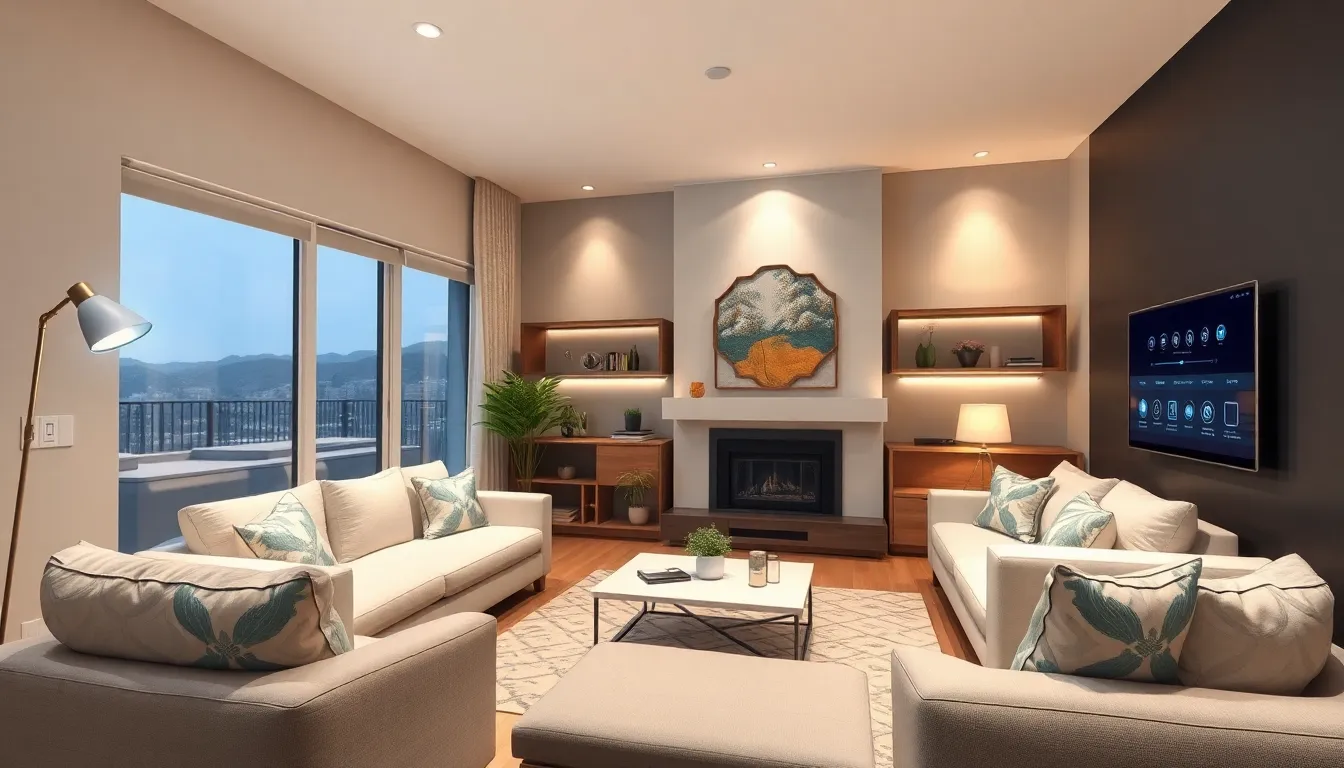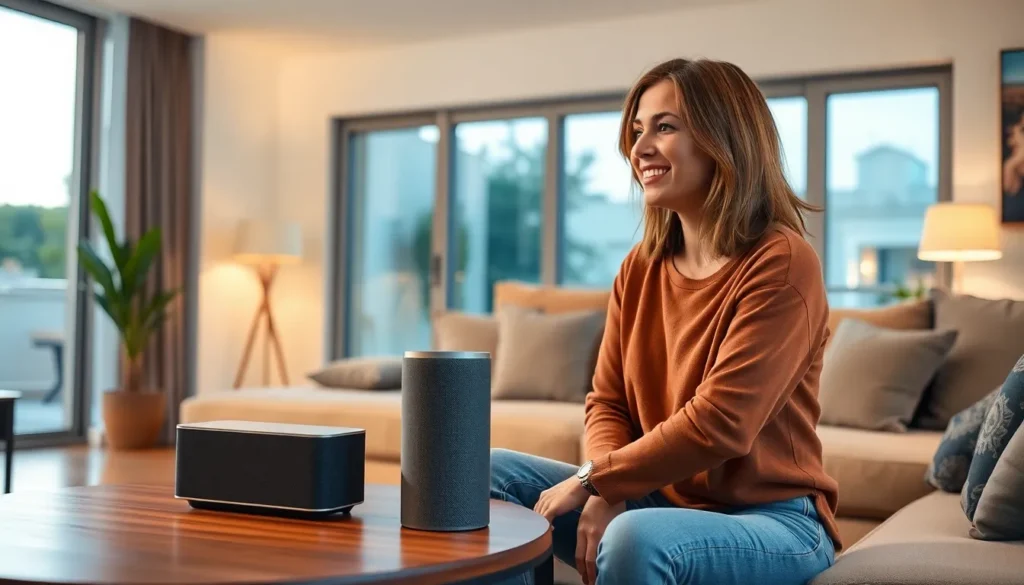Table of Contents
ToggleImagine waking up in 2024 and your home greets you like an overzealous butler. The lights dim to a cozy glow, your coffee brews itself, and even the thermostat knows just how to keep you comfy. Welcome to the world of smart homes, where technology isn’t just smart—it’s practically psychic.
As the year unfolds, smart home innovations are set to revolutionize daily life. From voice-activated appliances that can whip up dinner to security systems that make Fort Knox look like a garden shed, the future is here and it’s ready to impress. Get ready to embrace the convenience, efficiency, and yes, the occasional quirkiness that comes with a home that’s smarter than your average bear. Who wouldn’t want a house that can remind them where they left their keys?
Overview Of Smart Home 2024
Smart homes in 2024 promise to revolutionize everyday living through advanced technology. Home automation systems will integrate seamlessly, allowing centralized control over various devices. Voice-activated assistants will provide intuitive interactions, making tasks effortless.
Intelligent lighting systems will adapt based on natural light levels and individual preferences. In addition to energy efficiency, customizable settings will enhance moods in each room. Security features will include smart cameras and motion sensors, offering real-time alerts to homeowners.
Data collected from user behavior will help optimize home environments for comfort and efficiency. Smart appliances, like refrigerators, will monitor food inventory and suggest items for grocery shopping. Thermostats will learn heating and cooling preferences, minimizing energy waste by adjusting accordingly.
These advancements illustrate a growing focus on sustainability, with energy-efficient devices gaining popularity. Homes will feature solar panel integrations to reduce reliance on traditional power sources. Automation will not only improve convenience but also foster eco-friendly habits among users.
As innovators continue to develop smart technology, possibilities expand. Smart homes will likely include health monitoring systems, keeping track of metrics like heart rate and air quality. Collected data can help users make informed decisions regarding their well-being.
Moreover, 2024 will see an increase in the interoperability of devices from various manufacturers. This will create a cohesive ecosystem, allowing for seamless communication among devices in a home.
Adapting to certain preferences, these systems will enhance daily living, turning homes into environments that nurture comfort, security, and efficiency.
Key Features To Expect

Smart homes in 2024 will showcase remarkable advancements in technology, highlighting enhanced connectivity and intelligent automation. These features will empower homeowners while optimizing efficiency.
Enhanced Connectivity
Enhanced connectivity will play a crucial role in smart homes. Devices will communicate seamlessly with each other, creating an integrated ecosystem. Homeowners will enjoy centralized control through apps or voice commands. Smart hubs will manage multiple devices, eliminating the need for separate remotes or apps. Enhanced connectivity will also improve compatibility with various brands, allowing users to combine and personalize their devices. Additionally, faster Wi-Fi standards will ensure smooth data transmission across all devices. Real-time updates will keep homeowners informed about their systems, enhancing security and convenience.
Intelligent Automation
Intelligent automation will redefine daily routines. Smart systems will learn user preferences over time, adjusting settings autonomously. For instance, lighting will adapt based on occupancy and time of day, promoting energy savings. Automated schedules will manage heating and cooling, ensuring optimal comfort while conserving energy. Appliances will optimize their operation, integrating with renewable energy sources where available. Moreover, intelligent sensors will monitor environmental factors, providing recommendations for better health and comfort. As a result, homeowners can focus on enjoying life while technology works seamlessly in the background.
Popular Smart Home Devices
Smart home devices in 2024 enhance convenience and security, creating a more integrated living experience. Two essential categories include smart speakers and home security systems.
Smart Speakers
Smart speakers dominate the voice-activated market. Devices like Amazon Echo and Google Nest allow users to control various smart home features using voice commands. Music streaming, weather updates, and reminders become effortless with these gadgets. Numerous models feature built-in virtual assistants that improve day-to-day interactions. Compatibility with other smart devices grows, enabling users to manage lighting, thermostats, and even appliances via simple voice requests. Frequent updates ensure these speakers adapt to user preferences, transforming everyday tasks into smooth, enjoyable experiences.
Home Security Systems
Home security systems evolve rapidly in 2024. Advanced technology enhances safety through smart cameras, door sensors, and motion detectors. Users receive real-time alerts directly to their smartphones, offering peace of mind when away from home. Many systems feature integration with smart speakers, providing hands-free control of security settings. Remote monitoring also allows homeowners to view live feeds from cameras, ensuring constant vigilance. Additional features like facial recognition add an extra layer of protection. These innovations collectively create a comprehensive security solution that ensures comfort and safety for residents.
Benefits Of Smart Home Technology
Smart home technology offers numerous advantages, transforming daily living for homeowners in 2024.
Energy Efficiency
Energy efficiency becomes a key benefit of smart home systems. Smart thermostats learn user preferences, adjusting temperatures automatically to optimize energy use. Intelligent appliances track usage patterns, minimizing waste while providing valuable data on energy consumption. Lighting systems adapt to natural light, ensuring electricity is used only when needed. These enhancements lead to lower utility bills and a smaller carbon footprint. Installing solar panels alongside smart devices further promotes sustainability. The combination of these technologies empowers homeowners to manage energy consumption effectively.
Improved Safety And Security
Improved safety and security stand at the forefront of smart home benefits. Enhanced surveillance cameras provide real-time monitoring, alerting homeowners immediately to suspicious activity. Homeowners can control smart locks remotely, ensuring access is restricted to authorized individuals. Motion sensors detect movements around the property, triggering notifications on smartphones. These advancements integrate seamlessly with home automation, providing comprehensive security solutions. Additionally, smart smoke and carbon monoxide detectors alert users promptly, safeguarding against potential hazards. The overall effect establishes a sense of security, allowing families to feel safe and protected in their homes.
Challenges And Considerations
Smart homes in 2024 bring exciting possibilities alongside significant challenges. As technology advances, specific concerns arise, particularly regarding privacy and compatibility.
Privacy Concerns
Privacy remains a crucial issue with smart home devices. Users may feel uneasy about the data collected by voice assistants and security cameras. Data breaches can expose sensitive information, prompting fears of compromised security. Consumers rely on manufacturers to prioritize data protection through encryption and secure storage. Transparency about data usage is essential in building trust between manufacturers and homeowners. Regulators may increasingly scrutinize these technologies, leading to tighter privacy regulations.
Compatibility Issues
Compatibility presents hurdles in the smart home landscape. Smart devices from different manufacturers often struggle to communicate seamlessly. Homeowners face difficulties managing multiple apps or platforms, complicating user experience. Interoperability between brands becomes necessary for a smooth smart home operation. Standardization across the industry can foster consistency, providing clear guidelines for developers. Increased compatibility can enhance user satisfaction and streamline device management. As shared protocols emerge, efforts to address these challenges will likely shape the future of the smart home ecosystem.
Smart homes in 2024 are set to redefine how individuals interact with their living spaces. With advanced technology enhancing convenience and efficiency, homeowners will enjoy a seamless blend of comfort and security. The integration of intelligent devices promises to create a cohesive ecosystem that anticipates needs and simplifies daily tasks.
As sustainability becomes a priority, energy-efficient solutions will play a vital role in reducing environmental impact while lowering utility costs. However, addressing privacy concerns and ensuring device compatibility will be crucial for creating a trustworthy and user-friendly experience.
Embracing these innovations will not only improve daily living but also pave the way for a smarter and more connected future. The journey into smart home technology is just beginning, and its potential is boundless.







